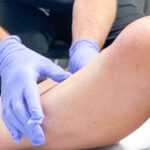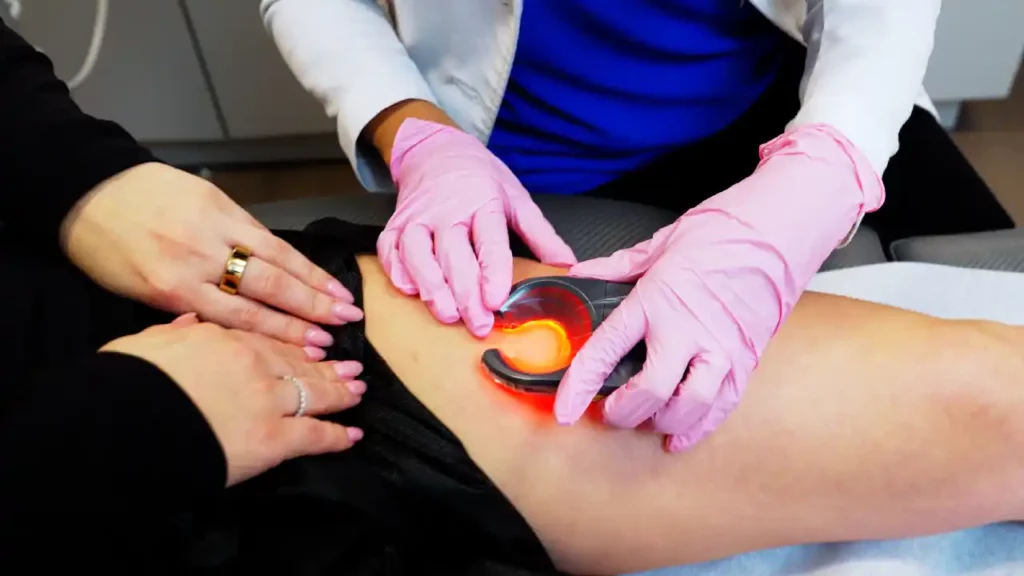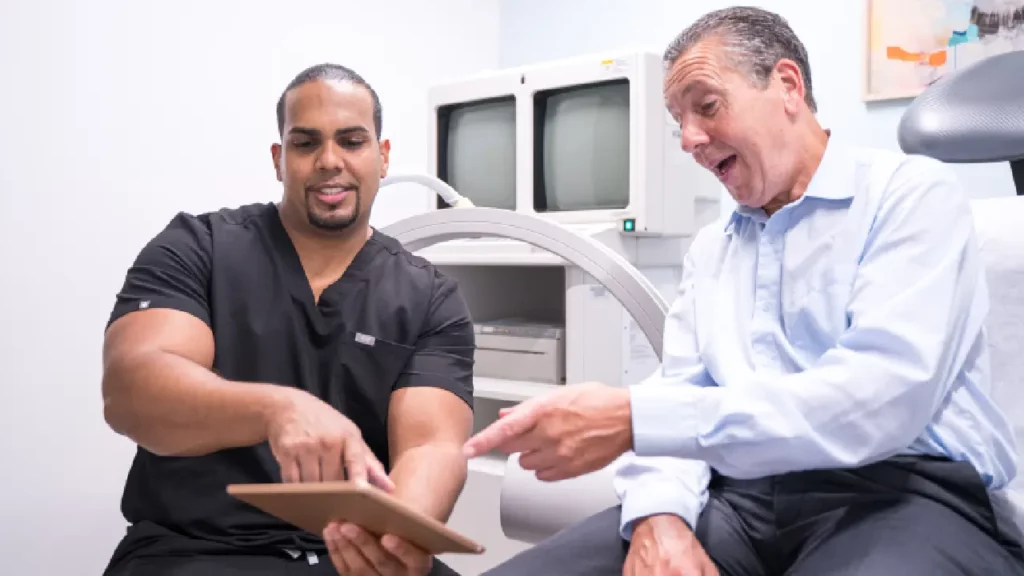The Future of CVI Treatment: Exploring Cutting-Edge Technologies
If you’re reading this, it’s possible that you’re suffering from chronic venous insufficiency (CVI) or suspect that you may have vein disease because of the symptoms — leg swelling, leg pain, leg heaviness, restless leg syndrome, and leg cramps. It’s possible that you’re concerned you’ll need surgical treatments for vein disease and varicose veins, but we assure you that’s not the case. In fact, thanks to recent advances in vein technologies, cutting-edge, minimally invasive vein treatments are safe, in-office procedures that conclude within an hour and involve no downtime, allowing you to resume daily activities immediately.
Gone are the days of complex surgical procedures like vein ligation and vein stripping, as cutting-edge technologies have ushered in a new era in the treatment of CVI. Vein Treatment Clinic only offers cutting-edge, minimally invasive vein treatments like endovenous laser ablation, radiofrequency ablation, Venaseal, Clarivein, and Varithena. Our vein doctors examine your leg veins, discuss your symptoms, administer ultrasound tests, and curate treatment plans to help you achieve optimal vascular health. Please schedule an appointment at your nearest vein treatment clinic — we have offices in New York, New Jersey, California, and Maryland.
This article explores cutting-edge technologies and treatments for chronic venous insufficiency.
Traditional Approaches: Surgical Treatments
Not too long ago, the standard methods for treating CVI involved procedures like vein ligation and vein stripping. These surgical interventions aimed to physically remove or ligate the malfunctioning veins. Here’s an explanation of how these procedures were performed.
Vein Ligation
This procedure involved making a surgical incision near the affected vein, often in the leg. The surgeon would then locate the problematic vein and tie it off (ligate) to prevent blood from flowing through it. Once ligated, the vein would become non-functional, and blood would be redirected to healthier veins. While effective in addressing CVI, this method was highly invasive, requiring significant incisions, and often resulted in prolonged recovery periods.
Vein Stripping
Vein stripping was a more extensive surgical procedure. It began with an incision at the groin or ankle, and a thin, flexible wire or catheter was threaded into the malfunctioning vein through this incision. The surgeon would then attach the wire to the vein and pull it out through the incision, effectively removing the entire vein from the body. This procedure was effective but came with a higher degree of invasiveness, resulting in noticeable scarring and an extended recovery period.
Drawbacks of Traditional Vascular Surgeries
Traditional vascular surgeries for treating chronic venous insufficiency (CVI) had several significant drawbacks, which prompted the development of minimally invasive alternatives. Here are some of the key limitations associated with these procedures:
- Required extensive incisions and surgical trauma to access and treat the affected veins
- Patients often experienced significant post-operative pain and discomfort
- Surgical incisions left noticeable scars on the skin
- Necessitated hospital stays and downtime for several days
- More expensive due to hospital stays and general anesthesia
- The recovery period for traditional vascular surgeries was considerably longer
- Increased risk of complications like infection, bleeding, and adverse reactions to anesthesia
- Unsuitable for high-risk candidates for surgery
- Precise targeting of malfunctioning veins could be challenging
- Scarring and potential cosmetic issues were a concern for many patients
Are you interested in getting more information about your condition or a treatment?
Fill the form below to start!



Cutting-Edge Minimally Invasive Vein Treatments
In the quest to provide more effective and patient-friendly solutions for chronic venous insufficiency (CVI), medical science has evolved to offer a range of cutting-edge minimally invasive vein treatments. These innovative approaches have replaced traditional, more invasive surgeries and are now the primary choice for treating CVI and its symptoms.
Endovenous Laser Ablation (EVLA)
Endovenous Laser Ablation, or EVLA, is a highly effective minimally invasive procedure for treating CVI. It relies on laser technology to address malfunctioning veins. A thin laser fiber is inserted into the problematic vein through a small incision, usually in the leg. Laser energy is emitted directly into the vein, heating the vein wall. This causes the vein to shrink and seal shut. Once the affected vein is sealed, blood flow is naturally rerouted to healthier veins. Over time, the sealed vein is gradually absorbed by the body, leaving no visible traces.
Radiofrequency Ablation (RFA)
Radiofrequency Ablation, or RFA, is another minimally invasive technique for CVI treatment that uses radiofrequency energy. A thin catheter is inserted into the affected vein through a small incision, usually in the leg. Radiofrequency energy is then applied through the catheter to the vein wall, causing it to heat up. This controlled thermal injury leads to the closure of the vein, blocking blood flow. Similar to EVLA, the body gradually reabsorbs the treated vein over time.
VenaSeal
VenaSeal represents a groundbreaking approach to CVI treatment by using a specially formulated medical adhesive. A tiny catheter is inserted into the malfunctioning vein through a small incision. The catheter dispenses a medical adhesive, which is distributed along the length of the affected vein. This adhesive effectively seals the vein shut, blocking the passage of blood. With the vein sealed, blood is rerouted to healthier veins, reducing CVI symptoms. Over time, the sealed vein is absorbed by the body, leaving no trace.
ClariVein
ClariVein is an innovative CVI treatment that combines mechanical and chemical approaches. A rotating wire tip is inserted into the vein via a catheter, mechanically disrupting the inner lining of the vein. Simultaneously, a sclerosing agent (a chemical solution) is infused into the vein. The combination of mechanical and chemical actions causes the vein to collapse and seal off. Blood flow is redirected to healthier veins, offering relief from CVI symptoms. Patients typically experience minimal discomfort and rapid recovery with this procedure.
Varithena
Varithena is an injectable foam treatment designed to address CVI, particularly for larger and more complex veins. A foam solution is injected into the malfunctioning vein. The foam displaces the blood within the vein and irritates the vein wall, causing it to collapse. The foam also serves to seal the vein shut, preventing further blood flow through it. Blood is rerouted through healthier veins, relieving CVI symptoms. Varithena is an effective option for patients with large varicose veins.
Ambulatory Phlebectomy
Ambulatory Phlebectomy is a minimally invasive procedure designed to remove superficial varicose veins. Tiny incisions, typically no more than 2-3 mm in size, are made over the varicose veins to be removed. A specialized hook-like instrument is inserted through these incisions. The surgeon gently grasps and removes the targeted varicose veins using the instrument. Because the incisions are small and no sutures are needed, scarring is minimal. Ambulatory phlebectomy removes visible varicose veins, while other treatments address the root cause.
Benefits of Minimally Invasive Vein Treatments:
Minimally invasive vein treatments represent a significant advancement in CVI treatment. They offer patients options that are less invasive, more comfortable, and have faster recovery times than surgical procedures like vein ligation and vein stripping. Our vein doctors perform thorough evaluations to determine the most suitable treatment option for your specific case.
- Require only small incisions or injections, minimizing surgical trauma to surrounding tissues.
- Patients typically experience less post-operative pain and discomfort
- Smaller incisions or injections result in minimal scarring
- Can be performed on an outpatient basis, eliminating the need for hospitalization
- Patients generally experience shorter recovery periods with fewer disruptions
- Carry a lower risk of complications such as infection and excessive bleeding
- Patients can expect long-lasting relief from CVI symptoms
Contact Us for the Future of CVI Treatment
If you or a loved one are ready to improve vascular health and treat chronic venous insufficiency for good, we invite you to schedule an appointment at the Vein Treatment Clinic. Our team of board-certified vein doctors is dedicated to providing you with the most advanced and minimally invasive vein treatments available. We offer thorough assessments and personalized treatment plans tailored to your unique needs, ensuring safe results with minimal risks.
We understand that navigating the complexities of insurance coverage can be overwhelming, which is why we offer free insurance verifications to ensure you receive the care you deserve. With state-of-the-art offices located in New York, Long Island, New Jersey, California, and Maryland, we are committed to making cutting-edge CVI treatments accessible to you. Contact us today to achieve healthy legs without the symptoms of venous insufficiency.









